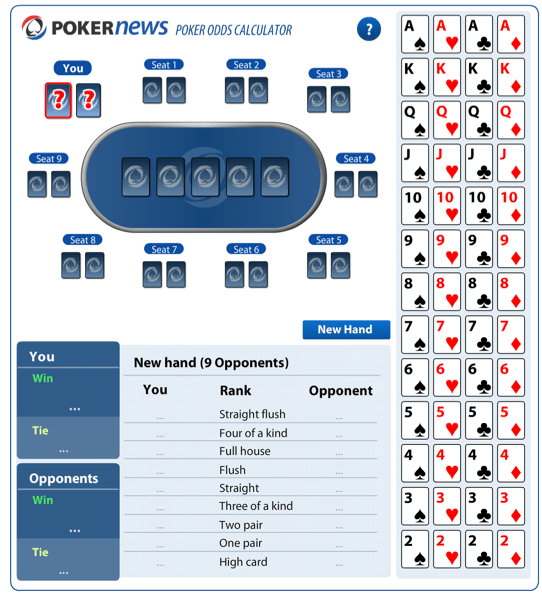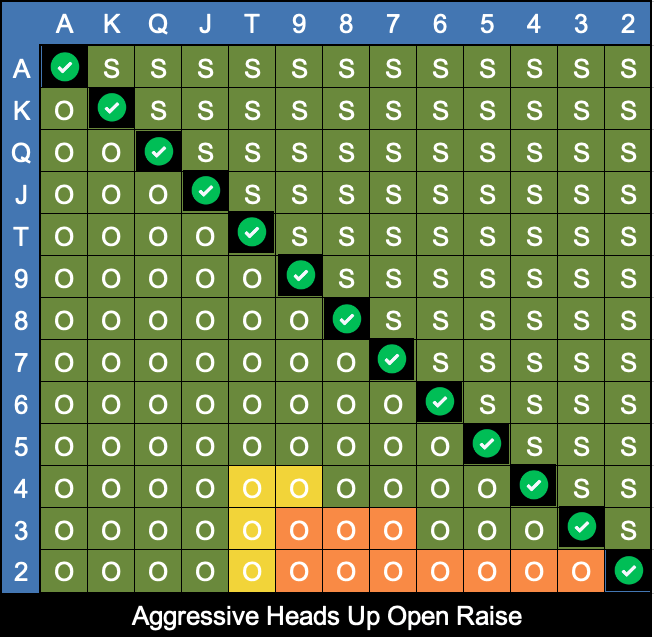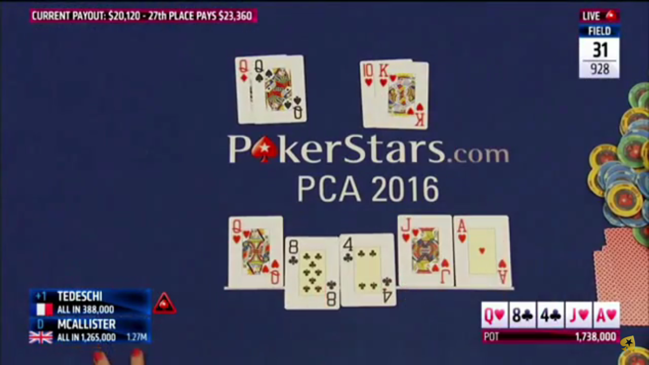Poker Heads Up Odds
Math is the underpinning of poker and if you regularly get your money into the middle with the worst of it you will go broke. One statistic that hasn’t been mentioned, and it’s one that I particularly like is this – the odds of both players being dealt Aces when playing heads up (one on one) is 270,724-to-1. This is a discussion on Help with heads up play within the online poker forums, in the Tournament Poker section; I am always getting beat heads up. I do fine 3 handed. It is same for cash games. The website is operated and managed by EveryMatrix Ltd., Poker Heads Up Odds Chart a company bearing registration number C44411, and having its registered address at Level 5, Suite 1A, Portomaso Business Tower, Vjal Portomaso, St. Julians, STJ 4012, Malta and by EveryMatrix N.V., a limited liability company incorporated under the laws of Curacao, bearing company registration number 108354. A Heads-Up Display, or HUD for short, is an online poker tool that allows you to display information directly on a poker table. This information ranges from statistics out of a tracking and analysis software database such as PokerTracker 3 or Holdem Manager to probability information provided by a calculator tool such as Holdem Indicator.
Stripper Stacks
Strippers are cards that are shaped in such a way as to allow them to be easily controlled by pulling them out of the deck, no matter where they are located.
A stripper stack uses this concept, along with carefully chosen cards, to enable a cheat to easily stack the deck in their favour.
A well known example of a stripper stack is the ten-card poker deal, which is a concept often used by magicians.
The Ten-Card Poker Deal
The ten-card poker deal came from the card table; it originally used nine cards and was specifically designed for a 5-card straight poker heads-up scenario.

The cheat would take nine cards from the deck, and cut them in such way that they could be stripped out when required.
Poker Heads Up Odds Genesis Open
In play, after the mark had shuffled, the deck would be passed to the cheat to be cut. The cheat would use the motion of cutting the cards to strip out the nine target cards and place them on top.
The result of this would be that the nine cards are dealt between the two players, with the mark’s final card being a random card from the deck.
The nine cards consisted of three sets of three-of-a-kind, which we will denote A, B, and C.
So the nine cards are: AAABBBCCC. As such there are a relatively small number of possible outcomes:
The table shows the probabilities that either party will win, given the way the nine cards come out, and whether the random card is helpful to the mark or not.
In most cases the random card is not useful, and the cheat will win. But occasionally the random card will improve the marks hand, and in some cases that may be enough to beat the cheat.
Overall, the cheat will win 96.01% of the time, whereas the mark will only win 3.99% of the time.
The advantages of this particular method of cheating, are that
- It only requires a single “cut” type action, which is built into the game’s procedure,
- It’s done on the opponent’s deal,
- It has a very high success rate.
The main disadvantage is that it requires stripped cards, which need to be put into the game somehow.
Getting Strippers into the Game
Cutting cards to make strippers is not generally something that can be done at the table, which leaves three options:
- Making sure the deck in play has already had the cards doctored
- Switching the deck or the required cards during play
- Cutting the cards from the deck in-play

The first method could be achieved by stocking the local shop with a large number of doctored decks and then insisting that a new deck is purchased before the game begins. Another method would be to have an accomplice who pretends to purchase a deck, but in fact just provides a prepared deck.
Alternatively, the deck could be switched before the game; again with an accomplice that has access to where the decks are stored.
A deck switch could also be done by the cheat during the game, either when they handle the cards to deal, or when given the cards for a cut. In some cases an accomplice may be used to provide a distraction whilst the decks are switched.
Depending on the style of strippers used, it may actually be only the target cards that need to be gimmicked. In this case they could be slowly switched out, one at a time, throughout the night as game play continues.
Finally, the cards in play could be cut, which would require stealing them from the deck, taking them somewhere private to put the work in, and then reintroducing them back into the pack.
A Stripper Stack for Heads-Up Texas Hold’em
Currently, the most popular form of poker is Texas Hold’em, which has quite a different format to straight poker.

Two face down hole cards are dealt to each player, then between rounds of betting, five communal cards are dealt face up on to the table. The players must make the best 5-card hand using their hole cards and the communal cards.
The aim would be to find a set of cards that can be stripped to the top in a single cutting action, and provide a high win rate, when playing heads-up Texas Hold’em.
The introduction of communal cards means that in many cases the winning hand is not decided until the final card comes down. This means that, selecting a set of 11 cards, such that the river card is random, makes the final result highly variable. So this is not a particularly effective strategy.
If the rules were loosened slightly to allow two ‘moves’, then 7 cards of one suit could be stripped to the top in the first action, and the ace of that suit stripped to the top in a second action. So, instead of ensuring that the mark is dealt a bad card, it’s ensured that the cheat is dealt a good card. In this case, both players would make a flush, and the cheat would win with the ace. This scenario produces a 100% probability of the cheat winning, as the ace high flush can’t be beaten, regardless of which cards are dealt on the turn or the river. However, there is the risk that the cards the mark ends up with are not good enough for them to want to bet on; so whilst the cheat will still win the hand, it may not be the biggest pot.
An alternative would be only controlling the hole cards, risking the fact that the 5 communal cards could completely change the winning hand.
By stripping three aces to the top on the mark’s deal, the cheat will ensure a pair of aces for themselves and the mark will be dealt at least one ace.
There are two advantages to this; firstly, giving the mark an ace may entice them to stay in the hand longer, giving the cheat the opportunity to win more. Secondly, the cheat holds the other two aces, which makes it unlikely that the mark will pair their ace. Furthermore, if the mark makes a hand with their ace, then in many cases the cheat will at least be able to equal the hand, and in some cases beat it.
To illustrate this advantage, the cheat’s pair of aces against any other two random cards, gives the cheat a win rate of 84.93%, the chances of drawing are 0.54%, and losing is 14.52% [results from wizardofodds.com]. Whereas, when the cheat’s aces are up against an ace and any other card, the cheat’s win rate is increased to 88.67%, the chances of drawing is increased to 3.17%, and crucially the probability of losing is now only 8.15% [results calculated with the help of cardplayer.com]. So by giving the mark an ace, the cheat’s chances of winning are increased, as is the chance of the mark making a bet.
Whilst this 88.67% probability of winning is not as high as 96.01% for the straight poker game, or the 100% for the flush scenario, it is still gives a reasonably high guaranteed edge.
To take this further, in The Mathematics of Poker, by Bill Chen and Jerrod Ankenman, a near optimal strategy is given for heads-up play when both player’s stacks are less than 50 big blinds. This strategy suggests that the only two moves in this scenario should be to jam or fold. The details of this strategy are described by a table, which give all possible hole card combinations, and assigns each a value. For the attacker, this value is the stack size in big blinds at which your play should switch from fold to jam. A second table is given for the defender, which dictates at what stack size their strategy should switch from fold to call.
When heads-up it’s common for the order of play to change. In standard multiway tables the player to the left of the dealer posts the small blind, the next player puts up the big blind, and the next player is the first to act. In this manner when heads-up, the dealer would put in the big blind and their opponent would act first. However, the change in play for heads-up means that the dealer acts first and their opponent puts in the big blind.
As the cheat is stripping the cards on the mark’s deal, then if the special heads-up order of play is enforced, the cheat is considered the defender. Whereas, if this change of play is not introduced, then the cheat would be considered the attacker.
Whilst the jam-fold strategy was developed for the alternate heads-up order of play, with the dealer acting first, results were calculated considering the cheat as both the attacker and the defender.
The following graph shows the cheat’s probability of success for a given opponent’s stack size. Where success would mean that the mark did not fold, and the pocket aces won the hand.
The cheat’s actions are clear, with their aces, they should jam if they are the attacker or call if they are the defender. However, the mark’s actions will depend on their stack size and what random card they get with their ace.
The graph shows that the cheat is more likely to succeed if they are the defender, which suggests that the alternate heads-up order of play is beneficial for this method of cheating.
As an example, if the mark has a stack of 40 big blinds, then there is a 60.64% chance of the mark going all-in and the cheat winning the pot.
For a 50% or greater probability of success, the cheat should use this technique when their opponent has less than 42.6 big blinds in their stack. Or 29.2 big blinds if the alternate heads-up order of play is not used and the cheat is the attacker.
Conclusion
The nine-card poker deal was designed for a game of straight poker, and gave the cheat a 96.01% chance of winning the pot. The required cards could be stripped out in a single cutting action, meaning that the play would take place on the mark’s deal.
Poker Heads Up Odds Nfl
Applying the same methodology to the game of Texas Hold’em is made more difficult with the introduction of communal cards. But by stripping only three aces, a similar outcome can be achieved; although the win rate drops to 88.67%.
Furthermore, using the near-optimal jam-fold strategy when the players are down to less than 50 big blinds, the cheats probability of success can be determined. These results suggest that the cheat has a greater than 50% success rate when their opponent has a stack of 42.6 big blinds or less.
Heads Up Poker Odds Chart
As a final thought, after the mark calls all-in and the cards are flipped over, they will likely realise that they are a severe underdog. This opens up the opportunity for making a deal and potentially dividing up the pot in a cash game, or deciding finishing positions and prize money splits in a tournament. Making a deal negates the risk of running the board and losing, for both players.

Poker Heads Up Odds Nfl Week 11
Return to Blog Posts